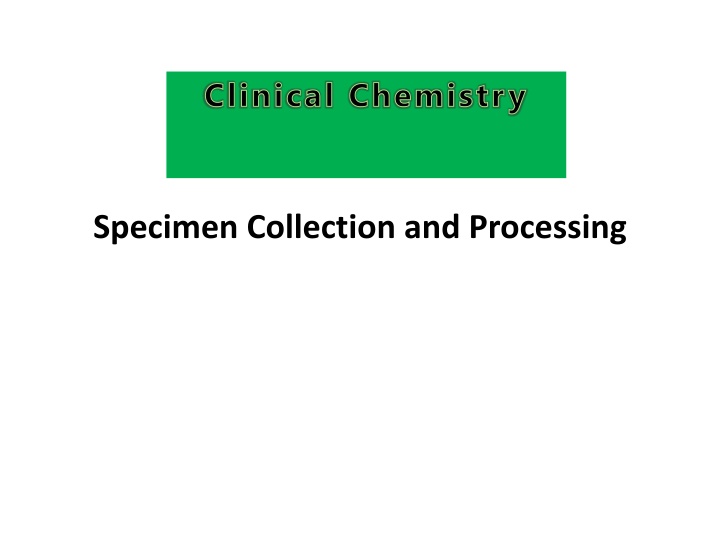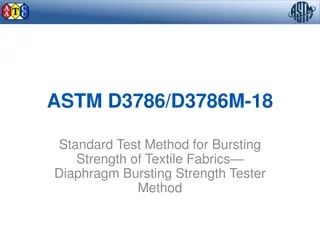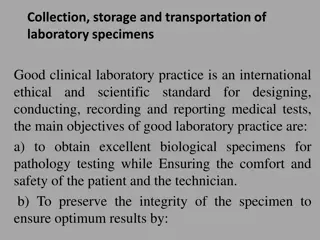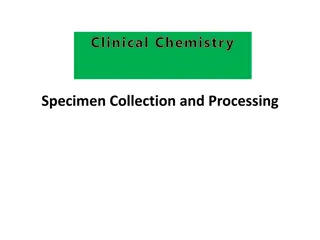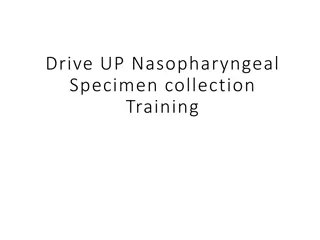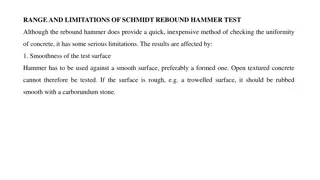Clinical Chemistry Specimen Collection and Processing Overview
Clinical chemistry specimen collection involves obtaining blood samples for analysis. Serum and plasma are commonly used specimens, each requiring specific handling. Different anticoagulants like heparin are used to prevent blood clotting during sample processing. Heparin, a widely used anticoagulant, accelerates the action of antithrombin III to prevent coagulation. However, heparin can interfere with some tests like PCR due to enzyme inhibition. Understanding proper specimen collection and anticoagulant use is essential for accurate clinical chemistry testing.
Uploaded on Oct 02, 2024 | 1 Views
Download Presentation

Please find below an Image/Link to download the presentation.
The content on the website is provided AS IS for your information and personal use only. It may not be sold, licensed, or shared on other websites without obtaining consent from the author.If you encounter any issues during the download, it is possible that the publisher has removed the file from their server.
You are allowed to download the files provided on this website for personal or commercial use, subject to the condition that they are used lawfully. All files are the property of their respective owners.
The content on the website is provided AS IS for your information and personal use only. It may not be sold, licensed, or shared on other websites without obtaining consent from the author.
E N D
Presentation Transcript
Clinical Chemistry Specimen Collection and Processing
Specimen Collection and Processing Anticoagulants and Preservatives for Blood Serum is defined as the watery portion of blood that remains after coagulation has occurred and is the specimen of choice for many analyses, including viral screening and protein electrophoresis. Samples are collected into tubes with no additive or with a clot activator and must be allowed to complete the coagulation process before further processing.
Plasma is defined as the noncellular component of anticoagulated whole blood and is increasingly being used for routine chemistry turnaround time. Sometimes considerable differences may be observed between the concentrations of analytes in serum and in plasma, as shown in Table 7-4. For molecular diagnostics, anticoagulated whole blood or plasma is more likely to be the specimen of choice. A number of anticoagulants are available, including heparin, ethylenediaminetetraacetic sodium fluoride, citrate, acid citrate dextrose (ACD, oxalate, and iodoacetate testing to decrease acid (EDTA),
Heparin Heparin is the most widely used anticoagulant for chemistry and hematology testing. It is a mucoitin polysulfuric acid and is available as sodium, potassium, lithium, and ammonium salts, all of which adequately prevent coagulation. This anticoagulant accelerates the action of antithrombin III, which neutralizes thrombin and thus prevents the formation of fibrin from fibrinogen. Most blood tubes are prepared with approximately 0.2 mg heparin for each milliliter of blood (1000 units/mL) to be collected.
The heparin is usually present as a dry powder that is hygroscopic and dissolves rapidly. Heparin has the disadvantages of high cost and a more temporary action of anticoagulation than is attained by chemical means, such as those discussed below. It produces a blue background in blood smears that are stained with Wright s stain. In addition, heparin is said to inhibit acid phosphatase activity and to interfere with the binding of calcium to EDTA in analytical methods for calcium involving complexing with EDTA.
It should be noted that heparin is unacceptable for most tests performed using the polymerase chain reaction (PCR) because of inhibition of the polymerase enzyme by this large molecule. In some special circumstances, a heparin tube can be shared with a molecular diagnostic laboratory if a nonheparinized tube is not available. DNA can be extracted from heparinized samples, but amplification may be reduced.
Ethylenediaminetetraacetic Acid EDTA is a chelating agent of divalent cations such as Ca2+ and Mg2+ that is particularly useful for (1) hematologic examinations, (2) isolation of genomic DNA, and (3) qualitative and quantitative virus determinations by molecular techniques, because it preserves the cellular components of blood. It is used as the disodium, dipotassium, or tripotassium salt, the last two being more soluble. It is effective at a final concentration of 1 to 2 g/L of blood. Higher concentrations hypertonically shrink the red cells.
EDTA prevents coagulation by binding calcium, which is essential for the clotting mechanism. EDTA, probably by chelation of metallic cofactors, inhibits alkaline phosphatase, creatine kinase, and leucine aminopeptidase activities. Because it chelates calcium and iron, EDTA is unsuitable for specimens for calcium and iron analyses using photometric or titrimetric techniques. As an anticoagulant, it has little effect on other clinical tests, although the concentration of cholesterol has been reported to be decreased by 3 to . % 5
Sodium Fluoride Sodium fluoride is a weak anticoagulant that is often added as a preservative for blood glucose. As a preservative, together with another anticoagulant such as potassium oxalate, it is effective at a concentration of approximately 2 g/L blood. It exerts its preservative action by inhibiting the enzyme systems involved in glycolysis, although such inhibition is not immediate and a certain amount of degradation occurs during the first hour after collection.
Citrate Sodium citrate solution, at a concentration of 34 to 38 g/L in a ratio of 1 part to 9 parts of blood, is widely used for coagulation studies, although the correct ratio of blood to anticoagulant is critical because the effect is easily reversible by addition of standard amounts of Ca2+ that are based on a proper collection volume. Because citrate chelates calcium, it is unsuitable as an anticoagulant for specimens for measurement of this element. It also inhibits aminotransferases and alkaline phosphatase but stimulates acid phosphatase when phenylphosphate is used as a substrate. Because citrate decreases the color yield in phosphate measurements that involve molybdate ions and produces low results. complexes molybdate, it
Oxalates Sodium, potassium, ammonium, and lithium oxalates inhibit blood coagulation by forming rather insoluble complexes with calcium (K2C2O4 H2O), at a concentration of approximately 1 to 2 g/L of blood, is the most widely used oxalate. At concentrations of greater than 3 g oxalate per liter, hemolysis is likely to occur. Combined ammonium and/or potassium oxalate does erythrocytes. However, other oxalates have been known to cause shrinkage by drawing water into the plasma. Reduction in hematocrit may be as much as 10%, causing a reduction in the concentration of plasma constituents of 5%. As fluid is lost from the cells, an exchange of electrolytes and other constituents membrane occurs. ions. Potassium oxalate not cause shrinkage of across the cell
Oxalate inhibits several enzymes, including acid and alkaline phosphatases, amylase, and lactate dehydrogenase, and may cause precipitation of calcium as the oxalate salt. Influence of Site of Collection on Blood Composition Blood obtained from different sites differs in composition. Skin puncture blood is more like arterial blood than venous blood. Thus there are no clinically significant differences between freely flowing capillary blood and arterial blood in pH, P CO2, P O2, and oxygen saturation. The PCO2 of venous blood is up to 6 to 7 mm Hg (0.8 to 0.9 kPa) higher. Venous blood glucose is as much as 70 mg/L (0.39 mmol/L) less than capillary blood glucose. Blood obtained by skin puncture is contaminated to some extent with interstitial and intracellular fluids. The major differences between venous serum and capillary serum are illustrated in Table 7-5.
Urine The type of urine specimen to be collected is dictated by the tests to be performed. Untimed or random specimens are suitable for only a few chemical tests; usually, urine specimens must be collected over a predetermined interval of time, such as 4, 12, or 24 hours. A clean, early morning, fasting specimen is usually the most concentrated specimen, and thus is preferred for microscopic examinations and for the detection of abnormal amounts of constituents, such as proteins, or of unusual compounds, such as chorionic gonadotropin. The clean timed specimen is one obtained at specific times of the day or during certain phases of the act of micturition.
